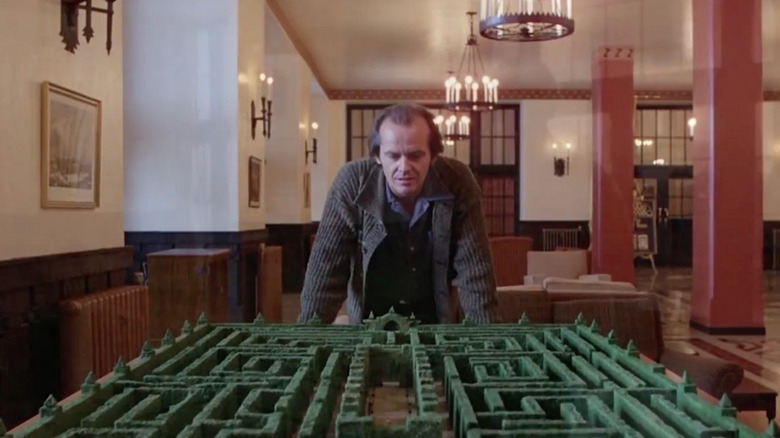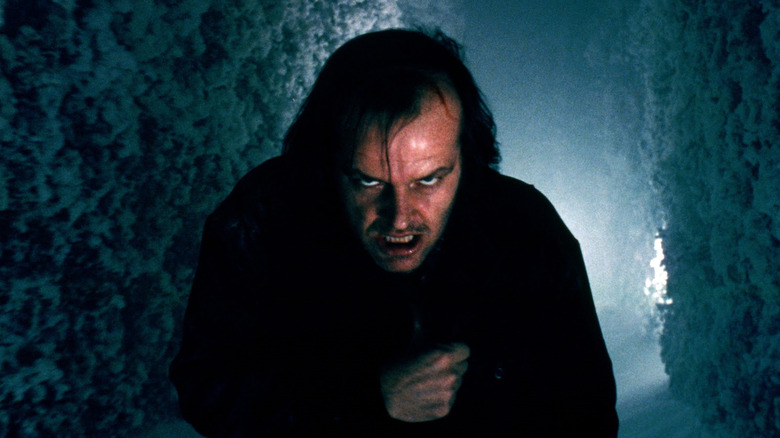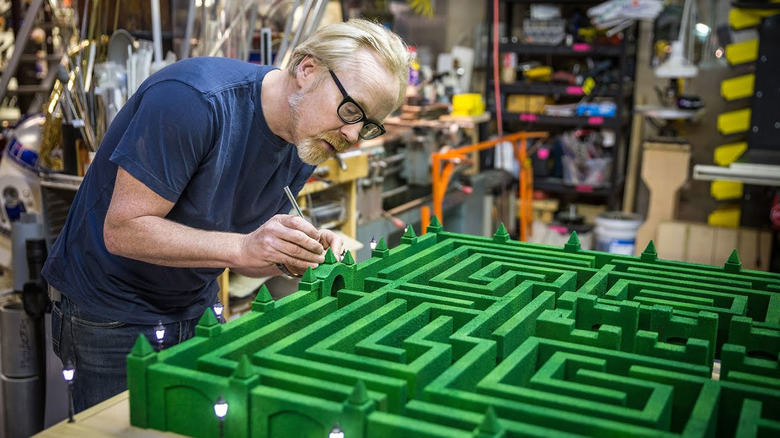The Shining's Hedge Maze Sets Were Just As Disorienting Behind The Scenes
An ill-advised tour of the snow-bound Overlook Hotel, as seen in Stanley Kubrick's 1980 horror classic "The Shining," can find menace in several of its nooks and crannies. The grim history of the hotel would leave supernatural traces behind –- Scatman Crothers' chef and telepath Dick Hallorann would liken the old hotel's malevolent presence to the scent of burnt toast –- in bloody elevators and time-warped ballrooms. However, one of the most intimidating places on the hotel grounds is a time-honored obstacle for fictional heroes: a towering labyrinthian maze, complete with its own axe-swinging monster.
Jack Torrance (Jack Nicholson) emerges as the Overlook's greatest weapon, prompting him to attack his family and chase his terrified child Danny (Danny Lloyd) into a nearby snow-flecked hedge maze in the film's climax (read more about the ending from /Film's Max Evry). An early scene in the film gives dimension to the maze without spoilers:
It's a dizzying sequence, filled with gliding, taffy-pulled tracking shots that would echo Danny's serpentine tricycle ride through the hotel's unending hallways, the final chase in the blizzard-blown maze, and any moment when Steadicam operator Garrett Brown is handling the lens. Brown, the gimbal-stabilized Steadicam's creator, could orient the lens wherever the director wanted, creating an immersive free-floating effect as the camera navigates the property. But even those with a map attached to their call sheets couldn't maneuver the Overlook maze set without getting lost. John Baxter's biography of Kubrick contains a treasure trove of insights on "The Shining," including a breakdown of the mazes seen onscreen and how bewildering the set would become for its camera operators.
Apocalypse (s)now
Stephen King's novel of the same title was released in 1977, when the American author was only 30 years old. He had two bestselling books to his name at the time, one of which was successfully adapted into a blood-soaked Brian De Palma feature. In King's "The Shining," the Torrance family tries to weather the slings and arrows of a haunted hotel as its caretakers during an isolated Colorado winter. The Overlook maze sits adjacent to the hotel as it does in Kubrick's movie, but within King's pages, the topiary hedge animals flanking the maze come alive like Weeping Angels or the Boo ghosts in the Mario games -– that is, they creep up on you when you turn away.
Ultimately, the terrifying topiary would be scrapped for Kubrick's adaptation (the faithful 1997 miniseries adaptation offers a CGI-free interpretation of the green beasts from King's pages) as part of a series of creative departures from the book. The biggest change would be the ending, which moves the action from the hotel's basement boiler room to an icy night within a web of greenery, courtesy of production designer Roy Walker and the art department (Walker, by this time, had already earned an Oscar for Best Art Direction on Kubrick's "Barry Lyndon").
Baxter's book describes the massive maze set, built on Stage 1 at the notable Elstree Studios. Under salt and crushed Styrofoam snow, the hedge network's walls were a series of movable "pine boughs stapled to plywood sheets" through which the crew should be able to sail through the sprawling set with ease. Instead, Baxter describes a crew "easily lost" within the ever-changing layout and the oily haze created by fog machines. Baxter quotes Garrett Brown as saying, "It wasn't much use to call out, 'Stanley!' as his laughter seemed to come from everywhere."
The most anxious garden stroll you'll take
One of the most fascinating tributes to the movie maze was a project of obsession for Adam Savage, special effects maestro and former co-host of "Mythbusters," who saw a replica model of the Overlook maze –- similar to the scale model Jack peers over in the hotel –- and felt inspired to make a more screen-accurate version. Working off of reference screenshots and meticulous math over the course of a month, Savage constructred an architectural model of the maze that's so close to the film's dimensions that it was later featured among highlights of the "Full Metal Jacket" director's archives in the world-traveling Stanley Kubrick Exhibition in 2016. You can watch the all-work-and-no-play breakdown here:
The hedge maze rivals flooding red elevators and a geometric carpet pattern as the most iconic imagery to last beyond Kubrick's "The Shining." Over 40 years after its release, the film's legacy is as complicated as the Overlook, a place that housed both actor mistreatment and transformative performances from two of the decade's great stars. Jack Nicholson, challenged to rise to new heights in his collaboration with Kubrick, would come to be more closely associated with the words "Here's Johnny!" than the late-night talk show host who inspired the improvised phrase. Even the book's author has since softened his initial criticism of Nicholson's casting in the lead role. Critics at the time were mostly unimpressed by Kubrick's detailed shot constructions and Nicholson's performance; their collected reviews qualify the movie as deserving of the "ahead of its time" label. These days, attitudes have changed and the film savors the view atop the heap of the scariest movies of all time.


